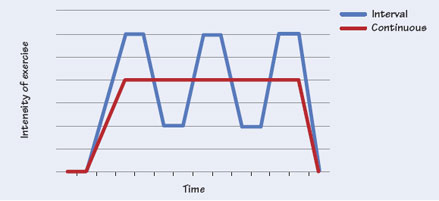
Step 3
Exercice program
Prescription of exercises
To build your exercise program, please look at the Integrating an exercise program into your life module from Living well with COPD
For an exercise program to be reliable and effective, it must be personalized in terms of:
- Intensity
- Length
- Frequency
- Continuous exercise or done at different intervals
- Type of exercise
- Progress
A well conceived program must include the following exercises:
- warm-up
- cardiovascular
- muscle strengthening
- flexibility and balance
Warm-up exercises
A training session should begin with a warm-up period that lasts a few minutes. Suffice to begin the session with a low intensity cardiovascular exercise, such as marching on the spot or another exercise with little or no effort.
Cardiovascular exercises
Cardiovascular exercises are very important, because they help improve a person's endurance.
Generally speaking…
- It is recommended to do 30 minutes of cardiovascular exercise every day.
- Three 10-minute periods of physical activities are just as beneficial as one period of 30-minutes straight.
- A program should consist of between three and five cardiovascular exercise sessions per week.
- The patient has to be taught how to use the pursed lip breathing technique during these exercises.
- The exercises can be done continuously, keeping the same intensity throughout the exercise period. They may also be done at different intervals, alternating between periods of high intensity and periods of lower intensity.

Choice of cardiovascular exercises
There exist a variety of cardiovascular exercises that can be very beneficial (aquafitness, dance, etc.). The exercises that are recommended most often are:
- walking
- stationary bicycle
- stairs
When walking, the use of a pedometer is recommended as both a motivational and self-assessment tool.
Muscle strengthening exercises
Basic rules
- For certain exercises, the weight of one's body is sufficient. For others, the use of weights or elastic exercise straps is preferable.
- Do the movements slowly. For example, take 3 to 5 seconds to bend and extend one's arm.
- Determine the right amount of effort. Teach the patient to repeat the exercise 12 times. The first few times should be relatively easy to do. The last ones (11th and 12th) should be quite difficult.
- Once the patient manages to repeat it 12 times without any difficulty, add another series of 12.
- The pursed lip breathing technique should be used. It is recommended to do the movement (keeping pace with the patient's breathing) upon exhaling.
- Make sure that one doesn't hold one's breath.
- These exercises should be done at least three times per week.
Flexibility and balancing exercises
After the cardiovascular and muscle strengthening exercises, one has to plan to spend a few minutes relaxing, so as to let the body return to a condition of rest. Muscle stretching should be done during this interlude. These exercises will build flexibility and provide relief. They also make it easier for people to do their daily chores, such as tying their shoelaces, washing themselves, etc.
General rules …
Before beginning these exercises, the patient should adopt an excellent posture. Either sitting down or standing up, the patient should lower their shoulders, and align their head and neck properly with their spinal column (as if their back was flush up against the wall).
- Maintain this position for 20 to 30 seconds for each stretch. The stretching should produce slight discomfort (but no pain).
- Each movement should be repeated once or twice.
- Breathing should be regular (without holding one's breath).
- Each stretch should be done gradually, without any sudden or abrupt spurts.
- Flexibility exercises will improve the patient's suppleness.
Please keep in mind:
- Training exercises for the upper and lower limbs should be done.
- Length of the program - At least 20 sessions should be given, and this, at least three times per week for the patient to enjoy the physiological benefits.
- High intensity exercises produce greater physiological benefits and should be encouraged. However, low intensity exercises are effective for patients unable to do high intensity exercises.
- Training at different intervals can be an effective way to enable the most symptomatic patients to do high intensity exercises.
- The combination of endurance and strength training generally produce several beneficial effects in addition to being well tolerated. Strength training is particularly recommended for patients with significant muscular atrophy.

